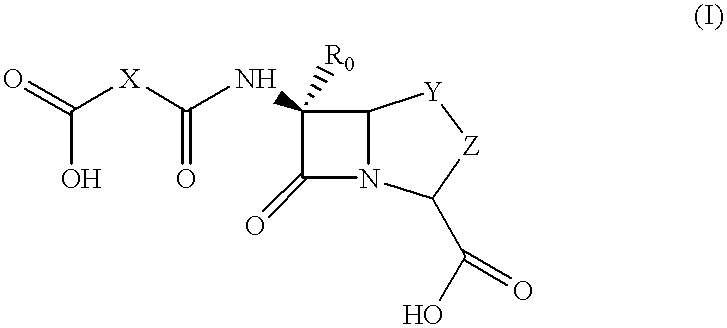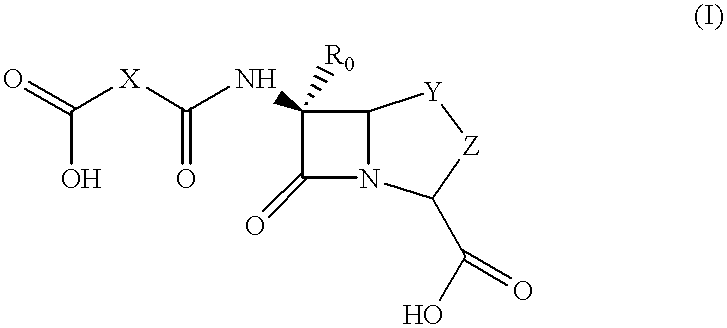Method for preparing a beta-lactam antibiotic
- Summary
- Abstract
- Description
- Claims
- Application Information
AI Technical Summary
Benefits of technology
Problems solved by technology
Method used
Image
Examples
example 1
Amoxicillin from N-adipyl-6.beta.-aminopenicillanic Acid and D-(-)-4-hydroxyphenylglycine Methyl Ester
[0053] To a solution of dipotassium N-adipyl-6.beta.-aminopenicillinate (0.71 g, purity 59%; 1.0 mmol) and D-(-)-4-hydroxyphenylglycine methyl ester (0.45 g, purity >97%, 2.4 mmol) in water (10 ml) was added dicarboxylate acylase obtained from Pseudomonas SE83 (1.044 g, 96 U.g.sup.-1) and penicillin acylase obtained from Escherichia coli (0.80 g, 125 U.g.sup.1). The mixture was stirred at room temperature and the pH was maintained at 6.9 using a 1M solution of sodium hydroxide in water. Formation of products was monitored using HPLC analysis. The results are shown in Table 1.
2TABLE 1 Time (h) Adipyl-6-APA (mM) 6-APA (mM) Amoxicillin (mM) 0 121 0 0 0.5 81 13 4 1.0 80 12 7
example 2
Cephalexin from N-adipyl-7-amino-3-methylceph-3-em-4-carboxylate and D-(-)-phenylglycine Amide
[0054] To a solution of N-adipyl-7-amino-3-methylceph-3-em-4-carboxylate (0.68 g, purity 97.1%, 2.0 mmol) and D-(-)-phenylglycine amide (0.75 g, purity 96%, 4.8 mmol) in water (20 ml) dicarboxylate acylase obtained from Pseudomonas SE83 (4.00 g, 369 U.g.sup.-1) and penicillin acylase obtained from Escherichia coli (1.6 g, 250 U.g.sup.-1) were added. The starting pH of the reaction mixture was 6.3, the reaction mixture was stirred at 35.degree. C., and after 30 minutes (pH=6.8) HPLC analysis showed the formation of Cephalexin. For HPLC analysis, 0.5 ml of the reaction mixture was taken out of the reaction vessel, centrifuged and from the filtrate, a volume of 0.2 ml was made up to 50 ml with buffer solution of pH 7. The results are shown in Table 2.
3TABLE 2 Time (h) Adipyl-7-ADCA (mM) 7-ADCA (mM) Cephalexin (mM) 0 95 0 0 0.5 34 35 9.9
example 3
Cephalexin from N-adipyl-7-amino-3-methylceph-3-em-4-carboxylate and D-(-)-phenylglycine Amide
[0055] To a solution of N-adipyl-7-amino-3-methylceph-3-em-4-carboxylate (0.68 g, purity 97.1%, 2,0 mmol) in water (20 ml) dicarboxylate acylase obtained from Pseudomonas SE83 (4.00 g, 369 U.g.sup.-1) was added. The reaction mixture was stirred at 35.degree. C. and the pH was maintained at 8.0 by using a 2 M solution of potassium hydroxide in water. After about one hour, the reaction contents were filtered and to the combined filtrate D-(-)-phenylglycine amide (0.75 g, purity 96%, 4.8 mmol) and penicillin acylase obtained from Escherichia coil (1.6 g, 250 U.g.sup.-1) were added. The reaction contents were maintained at 13.degree. C. and pH 7.5 by using a 1 M solution of hydrochloride in water. HPLC analysis showed the formation of cephalexin. For HPLC analysis, 0.5 ml of the reaction mixture was taken out of the reaction vessel, centrifuged and from the filtrate, a volume of 0.2 ml was made...
PUM
 Login to View More
Login to View More Abstract
Description
Claims
Application Information
 Login to View More
Login to View More - R&D
- Intellectual Property
- Life Sciences
- Materials
- Tech Scout
- Unparalleled Data Quality
- Higher Quality Content
- 60% Fewer Hallucinations
Browse by: Latest US Patents, China's latest patents, Technical Efficacy Thesaurus, Application Domain, Technology Topic, Popular Technical Reports.
© 2025 PatSnap. All rights reserved.Legal|Privacy policy|Modern Slavery Act Transparency Statement|Sitemap|About US| Contact US: help@patsnap.com



